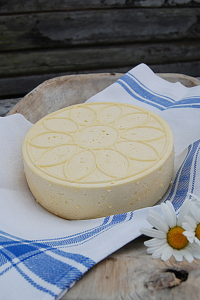How to Make Shieling Cheese
Heat the milk to 32 degrees. Add 1% fil and 0.5% yoghurt culture. This may need to be adjusted slightly depending on what your milk contains. Let the milk sit for 30 minutes.
Then add rennet. It’s available for purchase at some stores or pharmacies. Find out the required amount per litre of milk from the label on the bottle. If you have access to industrial rennet, take about 25 ml / 100 litres.
Let the milk coagulate for about 30-45 minutes. Check the curd with a knife to see if it is ready. Different types of milk have different speeds when it comes to the rennet process.
Cut or break the curd into as even grains of cheese (corn size) as possible. With a sharp knife or thin balloon whisk if you don’t have access to a real harp. The smoother the cheese grains, the better the drainage of whey, the better the cheese. Do not crush the curd. Then lots of protein and calcium will be lost into the whey.
Then stir the curd in and start heating to 38 degrees.
If you want to make a hard cheese, the size of the grains, the movement, the ph reduction and the heating are what make the curd release the whey. If you want to store a cheese for a long time, it is the whey content of the cheese that determines how long it can be stored.
After about 1 hour of breaking the curd and stirring, the curd is usually ready for absorption. Feel the grains of cheese, they should have a rind around them. Take a handful of curd in your hand and squeeze together into a “shesmus” cheese ball. If you can then break up the cheese ball so that each cheese grain regains its structure, the curd is ready.
What you use for cheese moulds is up to you. An old cookie jar with drilled holes works well. The more holes, the easier it is for the curd to drain whey. Putting a cheesecloth (cloth diaper, sheet cloth or the like) in the mould also helps with drainage.
Scoop away some of the whey first so it is easier to scoop up the curd. Turn the cheese at least twice in the first hour to get a nice even cheese. If you want, you can add a lid and a weight to add pressure to the cheese. About 5 kg should do the trick. A bucket of warm water can be useful. It also helps keep the cheese warm. Wrap the cheese carefully so that it stays at 20 degrees for the first 24 hours. Remember to flip it! If you are planning to sell it, take a final pH value after 24 hours. The optimum is 5.2–5.3 pH but never higher. If you have a lower pH, use less lactic acid culture next time, etc.
If you are going to cook whey butter on the whey, heat it up as quickly as possible. The lactic acid bacteria continue to work in the whey and lower the pH value. If the whey becomes too sour, the whey butter becomes sour. When heated, the pH drop is interrupted.

